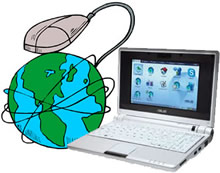Web Apps & Netbooks
 Sunday, July 6, 2008 at 10:12AM
Sunday, July 6, 2008 at 10:12AM  Two trends in the world of technology are making a big splash in education: web applications and netbooks. These trends excite me because I'm all about easy, free, and cheap.
Two trends in the world of technology are making a big splash in education: web applications and netbooks. These trends excite me because I'm all about easy, free, and cheap.
There are many tasks that used to require software that you can now do from inside of your Web browser. These sites and services are called web applications. They are sometimes called webware because they are like software but stored on the Internet instead of on a computer's hard drive. Web apps are great for students and teachers because they are usually free and do not require software to be installed. Because they run in a web browser, web apps are cross-platform, so it doesn't matter if you are running Windows, Macintosh, or Linux operating systems. Because Web apps and their data are stored online, students and teachers can access the apps and data from anywhere (this is called cloud computing). Teachers and students can access web apps on any school computer and also their computers at home. Some web apps even give access on mobile devices. Another bonus: web apps tend to facilitate online sharing and collaboration.
Simple Spark, a directory for web applications, has over 9,600 web apps listed. Here are some popular web apps for education:
- Google Docs - word processing
- Google Sheets - spreadsheets
- Google Presentation - slide shows
- Picnik - image editing
- Animoto - photo slide shows
- Poll Anywhere - surveys
- Spelling City - spelling list practice
- PTable - periodic table
- Sizeasy - compare dimensions of objects
- Kerpoof - animated cartoon movie creation
- Delicious - online bookmarking
Since web applications don't require a specific operating system, most all of them work perfectly fine on ultra-compact and inexpensive laptops like ASUS's Eee PC. The Eee PC 2G Surf model has a 7 inch screen, 3 USB ports, SD slot, 900 megahertz processor, Wi-Fi, 2 gigabytes of storage, and 512 megabytes of RAM. It uses flash memory, making for a 20 second boot-up time. It also has a VGA port for connecting a monitor or projector (super useful for showing the screen to a group of students).
The Eee PCs specifications aren't impressive, but its $299 price tag is. That's the entry level 2G Surf model's retail price. One way ASUS is able to keep costs down is that the notebook doesn't run Microsoft Windows. Instead, it runs a version of Linux, a free and open-source operating system. I have found learning to use the Eee PC really is easy. It's similar enough to Windows and Macintosh that I had no problem figuring out how to launch programs and save and open files. In fact, ASUS says the Es stand for "Easy to learn, Easy to work, Easy to play." By the way, Eee PC is pronounced with just one E (think E-P-C).
The Eee PC was a top-selling item for Amazon last Christmas. Its popularity has inspired other companies to come out with little notebook computers. Some of these include the HP Mini-Note, Everex CloudBook, and MSI Wind. See a chart comparing models. So far my favorite is the Eee PC because it has the lowest price. Anything above $300 has to get you wondering if your money should go to a full-sized laptop. Dell sells 15-inch laptops for less than $500.
The Intel company has coined the term netbook to describe small low-cost notebook computers with Wi-Fi. I like that term as these computers don't have lots of storage space or memory--but they don't need because their focus is on using the 'net and basic functions like word processing. (Laptop is not a fitting term because my Eee PC would fall between my legs if I tried to place it on my lap!)
Advantages to using netbooks in schools is that they are about the size of a hardcover book, easily fitting into a backpack. Would-be thieves can't tell a netbook is in a bag, unlike when students tote around laptop bags. Because netbooks are so small, they can have a place on a desk along with a textbook. Additionally, netbooks tend to have quick boot-up times, taking just 20 seconds to power on. Also, being relatively inexpensive, schools may be able to charge fines for broken or missing netbooks. Schools or parents may be able to take out insurance policies on netbooks too. Unlike handheld computers, netbooks look familiar to administrators, school board members, and the community. It's easier to convince those who control funds to purchase netbooks for students because they look like laptops.
There are a few disadvantages. For me, a 7-inch screen is useable, but I'd really rather have something larger. Netbooks do come with larger screens, but those pass the magical $300 price point. However, I don't think students will have the issues with the small screen as much as adults. Similarly, adults may have problems with the smallish keyboard but students, particularly younger ones with small hands, do not have any issues with it. Another disadvantage is battery life. I was able to get 2 hrs and 17 minutes of continuous Wi-Fi use out of my Eee PC. Though, more expensive netbooks have better battery life. I see classrooms that use netbooks needing lots of power strips to keep their computers charged. Also note that Netbooks are so small that they don't have CD drives.
A disadvantage that may actually be an advantage is that it may be hard for schools to decide which netbook to buy. The technology is continuously getting better and cheaper. What's important to me is a low price and wireless Internet access because I want to access web apps. When its time to replace or add more netbooks, it really doesn't matter much if the same exact model is available. Focusing on web apps means that any computer with a browser should work the same as what you already have.
In the fall I'm helping some schools use web apps and netbooks with students. Not only will you be reading more about these trends from me, but these are trends in consumer electronics and in education that you'll be seeing lots of in the coming year.

 netbooks
netbooks 





Reader Comments (6)
Tony,
I have enjoyed reading your post. I just want to add one thing. The ASUS eeepc with linux has another great advantage wich you did not mention. It can be reset to its factory-settings, making maintenance (think also of reuse by another person) a lot easier.
Johannes (Almelo, The Netherlands)
Just read your post. As a tech director at a district with a tight budget and a 1:1 push, netbooks seem to be an attractive option.
I question the purchase of a notebook when the students are utilizing a percentage of it's power. Why pay for a 100gig drive when most student work is stored online?
I think some vendors are going to need to re-think their pitch to districts. If I can purchase these type of 'appliance' machines, get online student accounts to many of these services, and save money and promote collaboration, that $1200 Macbook doesn't seem as nice a deal.
The bean-counters have long controlled how, when and where students will access to technology and thus have denied them creative control. We must change our approach - we need to find the total opportunity of ownership first before we consider the total cost of ownership.
Remember the pedagogy - creativity is at the top of BloomsV2 - not communication - the ASUSeePC is not a creative device - it a window to other resources but not a creative tool like the MacBook.
To be 21C learners that move beyond rip, mix and burn to grip, fix and turn (Flintoff, 2006) students need to be able to be used to create music, movies, 3D design and graphics. The ASUSeeePC is a communications tool not a creative tool. We may as well give them an iPod Touch instead. Extending students to help them develop higher-order thinking skills is not an easy task. Historically, teachers have looked to Bloom’s Taxonomy (1956) for assistance but this has proven to need rejigging for our times.
More recently, Anderson and Krathwohl (2001) have adapted Bloom’s model to fit the needs of today’s classroom by employing more outcome-oriented language, workable objectives, and changing nouns to active verbs (see this page).
Most notably, knowledge has been converted to remember. In addition, the highest level of development is create rather than evaluate.
In assessing effective contribution to learning, the design of these devices need to be seriously analysed for their ability to help students become content and knowledge creators rather than empty vestibules waiting to be filled. That is why the MacBook is still the best machine for 1:1 creativity based learning.
The price tag of the Asus eePC, for example, is clearly attractive at first glance, but a closer look reveals it is a device that cannot even run that dog of a program Windows MovieMaker. Unless the kids can tell their story effectively and be given a stage for their creative ideas these devices will lose their novelty within a month.
@Paul
The post is (as in the title) about
Web Apps & Netbooks, It's the combination of those two trends that will make a big splash in education. I also own and prefer a Macbook, but with the right applications on the web and and a simple window to it (netbooks) learning could be just as creative you wish them to be.
Johannes (Almelo, The Netherlands)
Yes - I agree. But not until 2012 at least. These tools are still to inflexible for digital storytelling and for students to be creative and express the complex (sometimes naive) media literacy they have.
When these webapps are available NetBooks and iPhones will become content creation devices. But not yet.
That's wonderful!